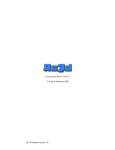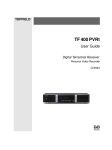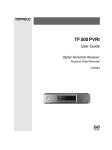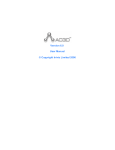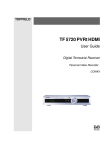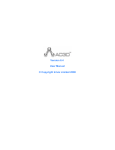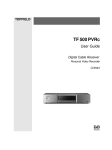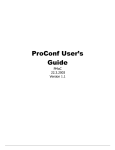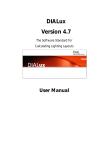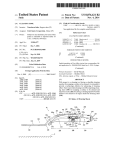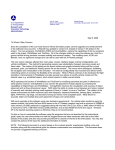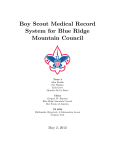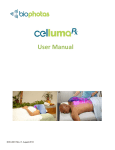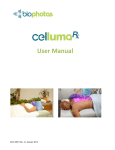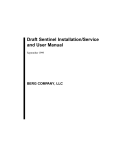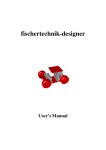Download AC3D Manual
Transcript
AC3D v3.6 User Manual
© Copyright Inivis ltd. 2003
AC3D 3.6 User Manual
© 2003 Inivis ltd.
All rights reserved. No part of this publication may be reproduced or transmitted in
any form or by any means, electronic or mechanical, including photocopying, recording
or storing in a retrieval system, or translated into any language in any form without the
prior written permission of Inivis ltd.
Software licence
The software described in this document is furnished under a Licence Agreement, which
is included with the product. This agreement specifies the permitted and prohibited
uses of the product.
Licenses and trademarks
Inivis ltd., the Inivis logo, AC3D and the AC3D logo are trademarks of Inivis ltd. All
other product names and any registered and unregistered trademarks mentioned in
this manual are used for identification purposes only and remain the exclusive
property of their respective owners.
Inivis
www.inivis.com
info @ inivis.com
AC3D
www.ac3d.org
support @ ac3d.org
AC3D User Manual
2
Contents
INTRODUCTION ...................................................................................................................... 6
Welcome to AC3D................................................................................................................... 6
AC3D terminology ................................................................................................................... 6
Windows/Views....................................................................................................................... 7
Control Panel ............................................................................................................................ 8
Toolbar....................................................................................................................................... 8
Orthographic views ................................................................................................................. 8
The grids................................................................................................................................ 9
Using Background Images.................................................................................................. 9
The 3D view ............................................................................................................................10
Getting help............................................................................................................................10
CREATING AC3D OBJECTS ................................................................................................. 11
AC3D Surfaces .......................................................................................................................11
Surface normals .................................................................................................................12
Creating new objects.............................................................................................................12
Polys/polylines/lines.........................................................................................................13
Spheres, boxes etc. ...........................................................................................................13
Creating other objects...........................................................................................................14
Lights.........................................................................................................................................15
Text...........................................................................................................................................15
Making your own fonts.....................................................................................................15
SELECTING, RESIZING AND MOVING ............................................................................... 17
Selecting ..................................................................................................................................17
Moving .....................................................................................................................................18
Resizing ....................................................................................................................................18
Extending/Negating the selection ......................................................................................18
Clearing the selection............................................................................................................19
Selecting in the 3D window..................................................................................................19
Hiding objects .........................................................................................................................19
Locking objects........................................................................................................................19
NAVIGATION AND VIEWING............................................................................................. 20
Moving and zooming the orthographic views...................................................................20
Navigation in the 3D window ..............................................................................................20
Spin mode ...........................................................................................................................20
Walk mode.........................................................................................................................20
Resetting views .......................................................................................................................21
Viewing the selection.............................................................................................................21
MODEL MANIPULATION ...................................................................................................... 22
Operations on objects ...........................................................................................................22
Revolving.............................................................................................................................22
Optimize Vertices ..............................................................................................................23
Optimize Surfaces .............................................................................................................23
Re-centre .............................................................................................................................24
Minimum-centre ..................................................................................................................24
AC3D User Manual
3
Fragment .............................................................................................................................24
Merge ..................................................................................................................................24
Explode ...............................................................................................................................24
Subdivide surfaces ............................................................................................................24
Reduce .................................................................................................................................25
Operations on surfaces .........................................................................................................26
Extruding .............................................................................................................................26
Flip normal ..........................................................................................................................30
Change vertex order........................................................................................................31
Divide...................................................................................................................................31
Spline ...................................................................................................................................31
Spike ....................................................................................................................................31
Make hole ...........................................................................................................................32
Bevel ....................................................................................................................................32
Triangulate..........................................................................................................................32
Cut away object ................................................................................................................33
Remap texture coors.........................................................................................................33
Remove surface only.........................................................................................................33
Operations on Vertices .........................................................................................................33
Snap-together ....................................................................................................................33
Snap-together-by-distance .............................................................................................33
Snap-to-grid.......................................................................................................................34
Snap-objects-by-vertices .................................................................................................34
Unshare................................................................................................................................34
Insert Vertex .......................................................................................................................34
Create convex surface/object ........................................................................................34
Create ordered surface ...................................................................................................37
Create 2D mesh .................................................................................................................37
TEXTURING ............................................................................................................................ 39
Setting a texture ....................................................................................................................39
Changing the mapping .........................................................................................................39
Remapping the texture coordinates...............................................................................39
Changing the texture repeat and offsets .....................................................................40
TOOLS.................................................................................................................................... 41
Model Information..................................................................................................................41
Render......................................................................................................................................41
Object hierarchy ....................................................................................................................41
Edit Object Data ....................................................................................................................42
The Texture Coordinate Editor ............................................................................................43
Selecting and manipulating .............................................................................................44
Remapping the selection ..................................................................................................46
Replicator ................................................................................................................................46
MATERIALS AND THE PALETTE............................................................................................. 47
Editing Palette entries ...........................................................................................................47
LOADING AND SAVING FILES............................................................................................ 48
Importing other formats ........................................................................................................48
AC3D User Manual
4
Triangle files.......................................................................................................................48
Vector files..........................................................................................................................48
Exporting files.........................................................................................................................48
VRML 1 ................................................................................................................................49
VRML 2 ................................................................................................................................49
DIVE......................................................................................................................................49
MASSIVE..............................................................................................................................49
RENDERMAN.......................................................................................................................49
POVRAY ..............................................................................................................................49
Triangle files.......................................................................................................................50
RENDERING............................................................................................................................ 51
A POVray example...............................................................................................................51
APPENDIX............................................................................................................................... 54
Performance tips ....................................................................................................................54
Keypresses...............................................................................................................................54
Preferences/settings ..............................................................................................................55
AC3D User Manual
5
Introduction
Welcome to AC3D
AC3D is designed to make the construction of 3d objects fast and easy to do. It
is used to create 3D models for games, rendering ray-traced images, and for
scientific and general data visualisation.
AC3D runs on a wide range of standard hardware and is available across a
number of popular platforms.
AC3D terminology
Vertex
A vertex is a single point in 3d space. It’s specified by three coordinates x, y
and z. More than one vertex can occupy the same position in 3d space. A
vertex is always owned by a single object, they cannot be shared between
objects. A vertex is usually part of a Surface, but need not be.
Surface
A surface in AC3D is a list of vertices. Surfaces are one of three types;
polygons, lines or polygon outlines. The type of a surface can be easily
changed. A surface normal specifies the direction a surface is facing. Normals
are used in lighting calculations. Surface normals are automatically calculated
AC3D User Manual
6
by AC3D. A surface is facing the viewer if the vertices can be seen in an anticlockwise direction. If a surface is set to be single sided, it will only be visible
from the front. Two sided surfaces will be visible from both sides. It is more
efficient to draw single sided surfaces and makes more sense when used as part
of an object such as a sphere (where you can’t see the other side of the
surfaces). Surfaces have a material attribute, which defines the color and
quality (for lighting purposes). Each vertex referenced in a surface has an
associated texture coordinate. Vertices can be shared between surfaces in the
same object.
Object
An AC3D object is a list of vertices, and surfaces that use these vertices. It also
has other attributes such as a name and texture.
Group
A group is a special object that has no surfaces or vertices but has other objects
as children. Groups are created by selecting two or more objects and selecting
‘Group’ from the edit menu, or toolbar.
Material
A material defines the color of a surface and also the attributes that define the
way it will react to light e.g. shininess.
Texture
Graphical images can be mapped onto the surfaces of an object. The images
are usually from graphics files such as gif, jpg, bmp etc.
Texture coordinates
When the vertex of a surface is drawn, a texture coordinate specifies the
position of a texture to map to that point. A texture coordinate is a two
dimensional (u,v) value.
Bounding box
When you make a selection of objects or vertices, a green box outlines it. You
can drag, resize or rotate this box to adjust the contents
Windows/Views
AC3D has a control panel, on the left, plus 4 other windows - three 2D
orthographic views and a 3D view. There’s also the menu and toolbar at the top
and an information bar along the bottom.
AC3D User Manual
7
Control Panel
This is where the main controls over the selection and draw
modes are located. It also contains the surface-type controls,
the palette of materials and the object name field.
The top of the control panel shows information about the current
selection. When the mouse is being used to interact with
models, this area will also display current positions, distances
moved and other related information.
Toolbar
This contains buttons for some of the most commonly used functions.
All – select everything.
None – clear the selection.
Del – delete the selected objects/surfaces or vertices.
Dup – duplicate the selection.
Cut, Copy, Paste – uses AC3D’s internal clipboard.
Group, Ungroup – put selected objects into a group/remove the group object
Flip XYZ – flip the section about this axis
200%/50%/+10%/-10% - scale the selection.
XY/ZY/XZ/3D/ALL – Maximise a single view or view ALL together
Orthographic views
The orthographic views consist of three 2 dimensional windows. These windows
allow selection and model manipulation (moving and resizing). Each
orthographic view shows a two dimensional view of the 3d world (front, side,
plan). Although it’s useful sometimes to work in a single view, seeing all the
windows at once can be very helpful when positioning objects and laying out
scenes.
AC3D User Manual
8
The dividers between the 4 view windows can be dragged to resize the views.
Individual views are maximized by clicking on the view buttons at the top right of
the main window (alternately, the F1-F5 keys can be pressed to switch between
the different view configurations).
The main window size/position and other settings are saved when exit AC3D.
The items on the ‘Orth’ menu control how the windows are drawn and what
components are visible.
The grids
In the orthographic windows, there are two grids - the draw grid and the snap
grid. Both can be set from 'File->settings' and can be toggled by pressing the
switches at the bottom of the control panel.
The draw grid displays visual guide lines in the orthographic windows.
The snap grid (if on) will snap moving/resizing/creating mouse movements to
nearest grid points. The Snap grid is shown by thin grid lines, the draw grid uses
thicker lines.
Both grids don't need to be set the same but they can be.
Using Background Images
Each of the orthographic (2D) windows can
display a background image. This can be
very useful for tracing shapes or laying out
objects in relation to some scanned image
AC3D User Manual
9
e.g. a map. Background images are set and unset from the View menu. All the
image formats that are supported by AC3D's texture loaders can be used.
The view menu contains items to Load and clear background images.
Background images will scale and
move with the views. By default, the
image will be centred on the origin.
The scale and position of the
background image is by adjusted using
alt and the cursor keys. Alt and the
cursor keys, reposition the image, whilst
Alt+Shift plus cursor up/down scale the
image.
Details of background images are not
saved with models or when AC3D exits.
The 3D view
The 3D view displays the current model in three dimensions and changes instantly
when any modifications are made to the current model. The 3D window is
primarily for viewing your models but also allows selection of objects, surfaces
and vertices (depending on the current Select-mode) by holding down the control
key and clicking/dragging.
Two navigation modes are available in this window – ‘spin’ and ‘walk’. These can
be switched in the 3D menu or by pressing the ‘1’ or ‘2’ keys whilst the pointer is
in the 3D window.
A 3d grid is available - toggle with 'g'. The grid is lies on the XZ plane (floor).
Press 'w' to toggle between wireframe and filled drawing, 't' toggles textures. 'l'
toggles the fixed light. See the 3D menu for more viewing options.
Getting help
User interface components in AC3D have
‘balloon help’. Small ‘tooltip’ windows will
popup when the mouse pointer rests over a
button or field label.
When browsing through the menu items, the
function on each item is described in the
message text at the bottom of the AC3D window.
AC3D User Manual
10
Creating AC3D objects
AC3D Surfaces
Objects in AC3D consist of a list of vertices and
a number of surfaces that reference those
vertices. A surface may be one of three types;
Polygon, Polyline or Line. A polygon is a filled
area, a Polyline is a wire-frame outline of the
polygon (a loop that joins the start vertex to the end), a line has a specific start
and end.
Surface type is changed by pressing a button
on the control panel. The Surface-type buttons
are located at the bottom of the control panel
(Poly, Polyline, Line):
This panel also contains controls to set surfaces to be smooth ‘SM’ or flat ‘FL’. This
determines the way that a polygon is drawn (it has no effect on lines or
polylines):
If a surface is flat-shaded, the colour across
the surface will be constant. If it is shaded then
the colour will be 'graded' depending on
lighting conditions.
Vertices can be shared between surfaces (i.e.
one or more surfaces use the same vertex). If these surface types are set to
‘smooth’, the effect is of one continuous 'smooth' surface. The vertices MUST be
shared for two surfaces to be smoothed together. This method of shading allows
smooth looking objects to be created from relatively simple shapes.
The '1S' and '2S' buttons select how many sides a surface has (one-sided or twosided). If a surface is single sided, it will only be visible from one side. The
following pictures aims to demonstrate this:
In this simple model, there are three objects - a green rectangle, a red rectangle
and a blue ellipse (made by creating an ellipse object and setting the surface
type to be POLY). The red rectangle has been set to be single-sided '1S'. This
means that it is visible from the 'front' but not from the back (the second image
AC3D User Manual
11
shows the whole model rotated). Objects such as spheres and cubes, which do not
have any interior surfaces visible, benefit from a speed optimization when being
drawn with the surfaces single-sided.
Surface normals
The direction a surface is facing is determined by its 'Normal' (indicated by
arrows in the above diagram). This is a 3D graphics term for a line at right
angles to the surface that indicates a direction. ). Normals are used to calculate
surface colors and shading when the objects in AC3D are drawn. For smooth
shading, vertex normals are automatically calculated by averaging normals of
all connected surfaces.
Normals can be visualised in both the orthographic and 3d views (‘Normals’ on
the ‘orth’ and ‘3d‘menus). This preview is useful for solving problems where, for
example, some surfaces in an object are the wrong way around (this can cause
surfaces to appear missing if they are one-sided, or the smoothing can appear
uneven. Viewing the normals is also useful for use with the extrude function and
can help determine the extrude settings that ensure that new surfaces face in the
correct direction.
This picture shows two spheres. The sphere on the left shows correct normals (i.e.
all facing outwards). The sphere on the right shows some surfaces facing in the
wrong direction. Notice how
the shading is not consistent.
AC3D automatically
calculates the normals (both
surface and vertex).
To flip the direction of a
surface, use Surface->Flip
normal. (This actually reverses the order of the vertices in the surface so that the
automatically generated normal faces the opposite way).
Creating new objects
The AC3D control panel contains a number
of 2D and 3D object shapes that can be
created:
New objects are created by selecting one of
these buttons and clicking/dragging in one
of the orth. windows.
AC3D User Manual
12
Polys/polylines/lines
To create a poly/polyline/line, click to position each point and either doubleclick or press the middle or right mouse button to end. The surface type can be
altered later from the control panel if you need a different type.
These objects consist of a list of vertices and a single surface. The surfaces from
more than one of these objects can be collected together into a single object by
using the Object->Merge function.
Polygons should be 3 or more points. Concave polygons are handled by AC3D.
They can be converted to triangles by using the Surface->triangulate function.
It is possible to draw a line or poly in different windows - creating a non-planar
object. This makes sense with lines but is not correct for a polygon which should
have all it's points on the same plane. Invalid polygons i.e. polygons that have
less than three vertices or have crossing edges are displayed in a cyan color.
To draw shapes that have vertices in the same position as an existing shape, use
the ‘nearsnap’ function. The switch at the bottom of the AC3D window is used to
control this. When this is on, the next point drawn will ‘snap’ to the nearest
existing vertex (when there is a vertex within a certain range).
Spheres, boxes etc.
Creating a 3D object by dragging the mouse in a window specifies two of the
dimensions for the new object - the third dimension is an average of the original
two. The location of the object in the third dimension is specified by the 3D
cursor. The 3D cursor is shown in the orthographics views by a cross. This is
repositioned by holding down the Alt key and dragging the mouse. Most people
rarely use this because it is very easy to
create an object and position it later.
Some object types allow parameters to be set
before creating the object. E.g. spheres and
Meshes can be made from triangles or quads.
Controls for any available parameters will appear in the control panel
underneath the mode box.
AC3D User Manual
13
When created, AC3D Objects are
automatically named. The object name box
is at the bottom of the control panel and
allows these names to be set.
Object names can only be edited/set in
Group or Object select mode. Object names need not be unique and can be the
same across multiple objects. This can be useful for selecting or finding
particular objects with the Edit->select-by-name function (e.g. to select all
objects named ‘chair’). Object names are used in some of the file formats
exported by AC3D.
If AC3D is being used to generate VRML or Dive files, URLs and other text can
be associated with objects. This text is used in a number of the export file
formats that AC3D generates. The names, text and urls are saved in the .ac
AC3D files. Text attached to each object is entered into the field on the Tools>Object Data window. Object names can also be set in the same dialog.
Creating other objects
It is very easy to create other objects from these shapes. E.g. to make a torus
shape (‘donut’), create an ellipse and select the Object->revolve menu.
A cone can be made in a number of ways. Create a cylinder; select one end (in
vertex mode) and select Vertex->snap-together. A cone made this way will have
the texture coordinates set correctly. For a simpler cone (fewer vertices), no
texture map), optimize the vertices with Object->Optimize-vertices. This means
that the centre-point of the cone will be a single vertex which is shared with all
the sides. Some other ways of making cones are - make a 'disk' and pull the
centre point up; revolve a line around an axis. To add a base to the cone, select
the bottom vertices and select the menu item: 'Vertex->Create surface/object'.
‘Extrude’ is used to add extra parts to objects or to give 2d shapes depth.
Objects can be cut into pieces and specific surfaces deleted.
AC3D User Manual
14
Lights
Lights have no associated geometry and represent a ‘point light’.
Lights are represented by this symbol:
This symbol is not shown in the 3D window but the effects of the light on other
objects in the scene will be noticeable.
Lights are fixed brightness white lights. Lights are selected and repositioned in
Group or Object select mode.
Lights are generated in POV files and RIB files. The generated files can be
edited to alter the lighting attributes.
This image shows a green sphere with two lights
(indicated by white spheres) - the main headlight
is off. (The headlight in the 3D window is toggled
on and off with the 'l' key, or from the ‘3D’ menu).
If the headlight is on when POV or RIB files are
generated, a light will be added to information in
the file.
Text
Tools->Add-Text is a function that
creates text from a special AC3D file.
An AC3D font file contains a set of
objects that are treated in a similar way
to a text font. The font file can be
viewed by simply loading it in to AC3D.
Objects are named to be letters in the
alphabet (and other symbols too). Add-Text takes a string (e.g. your name) and
duplicates these objects, laying them out next to each other. The text is created
at the origin (0, 0, 0) and will usually be facing so that it's viewable in the XY
(side) window. This text can be selected and moved, resized, or rotated just like
other AC3D objects. The Extrude function can be used to make this text threedimensional.
Making your own fonts
A file for use with Tools->Add-Text is a normal AC3D file with named objects. Objects have their centres (origins) ‘minimized’ (set using the Object->Minimum
centre function). To view object-centres, ensure that the '+' button is on (at the
bottom of the control panel). This point is used when lining up text objects. The
AC3D User Manual
15
point is taken as the start of the 'character' and the width of the object is
measured so that the next character can be placed the correct distance along
the line, without overlapping. The font file should be designed to be viewed from
the front in the XY window, since these coordinates are used for positioning the
font objects.
The Add text function can be useful for storing a library of objects e.g. furniture.
Each object can only be indexed by a single character.
To create accurate 3D text objects from TrueType fonts (as used by Windows
etc), use Font3D to generate DXF files and import them into AC3D. Font 3D is
free to download from http://www.checkpoint.net/font3d/
Registered users benefit from a special Font3D plugin.
AC3D User Manual
16
Selecting, resizing and moving
In AC3D the manipulation of 3D objects
works in a very similar way to a 2D drawing
program. I.e. the selection is shown
highlighted and ‘handles’ can be moved to
reshape the section.
The majority of selection and manipulation is
done through the orthographic windows
although selection is possible via the 3D view.
Selected components (surface, vertices) are shown in a different colour and are
surrounded by a ‘bounding box’ (usually green).
Selection is possible in mode/size, rotate
and extrude modes. The default mode is
move/size.
Note that the extrude button is disabled in this picture – it’s enabled only in
surface select mode.
Selecting
The Select-mode defines the granularity of
selection i.e. it determines if selections will
affect objects, groups or vertices. To select
in AC3D, either click the left mouse button or use the left mouse button to drag a
box over an area. When something is selected, the Bounding-Box that appears
can be dragged or resized directly affecting the points/surfaces/objects.
In Vertex mode, vertices are selected by a single click on a single vertex or by
dragging a box over a number of vertices. In Surface-mode, a surface is
selected by a click or dragging a box over an area. In Object-mode, selecting
any part of an object causes the whole object to be selected. In Group-mode, a
group of objects can be selected by highlighting any part of a single object that
belongs to a group.
There is an important difference between a click-select and a drag select. Click
selects are used for selecting single entities e.g. one object, one surface, one
vertex. A click select will select the nearest entity underneath the pointer. A
drag-select will select everything within the drawn box that lies underneath the
AC3D User Manual
17
region. Click-select is useful, for example, when selecting a single surface of a
sphere (where a drag select will always select more than one surface).
Selections are preserved between changes of select modes. Changing from
vertex to surface select-mode means that any surfaces that have all vertices
selected will remain selected in surface-mode.
Moving
The green bounding box is dragged with the
left mouse button to reposition the selection.
Holding the control key down whilst dragging,
constrains movement to up/down or left/right
only.
Resizing
Drag the ‘handles’ in the corners of the
bounding box using the left mouse-button, to
resize the selection. On the edge handles,
hold the control key down whilst moving the
mouse to resize opposite edges.
Note that it is possible to resize a selection
down to zero width. This is useful for lining up
vertices.
Extending/Negating the selection
Holding down the shift key whilst selecting with the left mouse button, extends the
selection (adds new entities) and pressing shift whilst selecting with 2nd (or 3rd)
mouse button to negate (subtract) items from the current selection.
Extend and negate selection work in all select modes.
This picture shows the top and bottom of a sphere selected. This is done by first
selecting the top vertices with a drag. Holding down
the shift key and dragging across the bottom of the
sphere.
AC3D User Manual
18
Clearing the selection
Clicking the outside the area of the bounding box will cause everything to
become unselected
The selection can also be cleared by pressing the ‘None’ button in the toolbar or
from the menu Edit->select-nothing.
Selecting in the 3D window
This works in the same way as selecting/extending and negating in the orth
windows, but requires the control key to be held down.
Hiding objects
Hiding allows objects to be temporarily
removed from the views. The current
selection, or objects that are not selected, can
be hidden from view. The 'unhide' button ensures that all objects are visible. The
'3d' toggle determines if the hidden objects are visible in the 3d window. Hiding
is useful when access is needed to work on obscured objects.
Locking objects
This is useful for temporarily disabling objects
that are obscuring others. When objects are
locked, it’s not possible to select them.
Locking also helps with the speed performance when editing large models. It
works in a similar way hiding, only that locked objects are drawn in grey
wireframe. Wireframe surfaces take less time to draw compared to filled
surfaces.
Note that if objects are hidden (or locked) and the model is saved/exported,
hidden/locked objects are included in the file.
AC3D User Manual
19
Navigation and viewing
Moving and zooming the orthographic views
Dragging the mouse when holding down the middle button ‘pans’ the window.
The right mouse-button zooms (magnifies and minifies). Alternatively, holding
down the control key and using the right mouse button will pan the view.
The views in the orthographic windows can also be repositioned with the cursor
keys. Pressing shift with the cursors keys moves in larger steps. To zoom in and
out, use control and the cursor keys (or 'z' to zoom-in, 'x' to zoom out).
The window zoom can be set to be the same for all 2D windows from the settings
dialog (File->edit settings menu), otherwise windows will have independent zoon
settings.
Navigation in the 3D window
There are two viewing modes accessible by pressing '1' and '2' in the 3d window
(or by selecting the menu items in the '3d' menu):
Spin mode
In 'spin' mode, holding down the left mouse button and dragging the mouse
rotates the view. Holding down the right mouse button and dragging the mouse
vertically zooms (scales) the view. Middle mouse button dragging will ‘pan’ the
view. Alternatively, holding down the control key and using the right mouse
button will also pan the view.
The cursor keys can also be used to control the spin (control plus up/down zoom
in/out).
Walk mode
In ‘walk’ mode, the cursor keys work in a similar way to 'Doom/Quake'. The '2'
key switches into this mode ('1' switches back to spin mode). Cursor up/down
moves forwards/backwards, cursor keys left/right turn. Pressing control with the
cursor keys up/down tilts the view position and alt moves (pans) left, right, up,
down.
Walking can also be controlled with the mouse - the left button turns and moves
forward and backward, the right button controls up/down/left/right movement.
AC3D User Manual
20
Resetting views
Press the 'space' key to center that windows about the origin and reset the zoom
levels.
Viewing the selection
Press 'f' to fit the current selection into the current window. 'F' fits the selection to
all windows. Control-F fits the whole model into all views. Use 'g' to 'goto' the
current selection - the window will centre about the centre of the selection. 'G'
centres all windows. These options are also in the View menu.
Three functions available from the View menu allow you to centre the 3D view
about the selection, the cursor (that is positioned with ALT-click in the 2D
windows), and reset to view the origin.
AC3D User Manual
21
Model manipulation
Operations on objects
These operations are on the ‘Object’ menu and act upon one or more selected
objects.
Revolving
Revolving makes copies of the selected objects, rotating each copy, then creating
surfaces between the copies. It’s recommended that this function be used to
revolve 2D outlines of shapes rather than filled-polygon objects. Any revolved
line objects are automatically removed after the revolution. The axis to perform
the revolution about can be altered.
To create a torus - make a circle in
the Front window:
Select 'Object->Revolve…'
Set the axis to Y and click
Revolve. You should see
something like this:
Select the
'smooth' surface
type (near the
bottom of the
control panel) to
make it appear
rounded
AC3D User Manual
22
The degrees of revolution can also be altered 1-360 degrees:
If there are points that need to be in the centre of the final revolved object (e.g. the start and end points of the cup profile above) then these points must lie
exactly on the axis. Drawing the line with ‘gridsnap’ can ensure this.
Alternatively, snapping the points to the grid (Vertex->snap to grid) or by using
the control panel Move-to function to ensure that two of the values are zero. If
these points are not exactly on the axis, a small hole or possibly overlapping
surfaces will be created. If this happens, the 'Vertex->snap together' function
and optimize vertices can be used to remove duplicate points.
Optimize Vertices
This function removes duplicate vertices from each selected object. For vertices to
be removed, an object must own the vertices and they much match the same
position exactly. The function will share one vertex between each connected
point. This means that vertex normals can be calculated if smooth shading is
required. This function also removes duplicate vertex references from the surface
- something that might cause a bad polygon. If vertices do not match the same
position, Vertex->snap-together or Vertex->snap-together-by-distance can be
used to move them to the same point.
Optimize Surfaces
This function removes any duplicate surfaces and any polygons that consist of 1
or 2 vertices (these may exist if vertices have been deleted from an object).
AC3D highlights invalid polygons by displaying them as cyan lines.
AC3D User Manual
23
Re-centre
Object centres define the local origin of AC3D objects. Object centres can be
seen by switching on the '+' button at the bottom of the control panel. This
function re-centres this origin at the objects centre of gravity. This can be useful
for specifying where the pivot points or local-origin of an object are.
Minimum-centre
This function sets the object's origin to the minimum xyz of the object. It is used to
create AC3D fonts for the Tools->Add-Text function.
Fragment
Fragment creates one object per surface of the original
object so that each object contains only one surface and
the necessary vertices. This image shows a sphere that
has been fragmented. The new objects have been moved
apart. Notice that the surfaces are no longer 'smoothed'
together - this is because each surface is now a separate
object and vertices cannot be shared across objects.
Merge
This function places all of the surfaces from the selected objects into one single
object. This does not optimize the vertices so that they are shared. (select
'optimise vertices after merging to create a more efficient object and/or get
smooth shading across adjacent surfaces)
Explode
This is similar to fragment, but each new object is moved
forward (in the direction the surface is facing) by a specified
amount. This picture shows an exploded cube.
Subdivide surfaces
This function is used to ‘smooth’ the edges of an object. This picture shows four
cubes. The first is a standard box; the others have had surface subdivision
applied one two and three times.
AC3D User Manual
24
The same objects with their surface set to ‘Smooth’ (SM button on control panel):
Note that this function always creates triangles. Each subdivision quadruples the
number of triangles in an object.
Reduce
This function reduces the number of vertices (and polygons) whilst trying to retain
as much of an objects original shape as possible. This is useful for saving on
storage space and for speeding up the rendering of complicated objects. This
function can be used to create different objects that will be shown at different
distances (LOD – level of detail). E.g. a car object should be viewed close up
with all polygons but from a distance, a more simple shape is adequate and can
save drawing time.
A target percentage specifies the proportion of vertices that are to remain. E.g.
If an object has 100 vertices and 80% is entered, the final object will contain 80
vertices.
The original object can remain in the model, or it can be replaced with the new
object. If the original object is kept, the new object will be created in the same
position and will be selected.
AC3D User Manual
25
An example:
732 surfaces, 376 vertices
Reduced by to 40% gives:
276 surfaces, 150 vertices – A saving of 456 polygons.
The reduce window remains visible so that different reductions can be tried (use
Edit->Undo to revert to the previous state).
Operations on surfaces
Extruding
Extruding works only in surface select-mode. Pressing the extrude button on the
control panel when there are one or more surfaces selected, enables the function.
The actual extrude is done after the selection is dragged.
AC3D User Manual
26
Extruding is a very powerful function that can be used for a number of tasks. It
works by making new surfaces at the edges of the current selection. The original
selection can be removed and/or copied to the end of the new surfaces.
Selecting one of more surfaces and
selecting the extrude button on the
control panel, brings up the extrude
parameters:
Here the number of sections to produce is
specified. The end of new object can be capped
with a copy of the original selection. New
surfaces can have their normals reversed.
Removal of the original surfaces is also an option.
After setting these parameters, bounding box is
dragged in the desired direction. (if the control
key is held down movements of the mouse are constrained to either horizontal or
vertical.)
The extrude function is best demonstrated with some examples. (This star is
made by creating a 10-sided disk, selecting alternate vertices and shrinking the
selection, using the –10% toolbar button a few times).
The magenta lines shown here represent the
normals. Normals can be displayed by
switching on ‘Show normals’ from the Orth and
AC3D User Manual
27
3D menus. Displaying the normals is used here to help determine the direction to
extrude the object. In the extrusion, if the selection is dragged in the same
direction as the normals, the resulting shape will hide the front of the original
surfaces. This is good if you are, for example, extending one side of a box, but
in this case we want the original surfaces to be on the outside of the final shape.
This means that we want to drag the surfaces in the opposite direction that the
normals face. Because we are doing this, we need to ‘flip new surfaces’ so that
all the new surfaces face outwards.
This is what happens when we drag the selection up in the plan window.
If we ticked ‘remove original’ here then the star that we are dragging will be
deleted:
Here you can see that the original surfaces have been removed to leave a start
shaped box (without a lid). If we’d un-ticked ‘cap end’ then we’d be able to see
right through the star shape.
AC3D User Manual
28
This picture shows what happens when sections is set to 4.
If you need to extend an existing set of surfaces, you may not want to keep the
existing surfaces inside the new object.
Here is a cube that has had a single ‘Surface->divide’. Two of the surfaces are
selected.
We can extend these surfaces without keeping
the original surfaces (since they will not be
visible because they are inside the shape. We
use these settings:
To perform the extrusion, we drag the bounding
box to the left (in either the front or plan window), holding down the Control-key
as we drag to ensure that the new surfaces are square to the original. This gives:
AC3D User Manual
29
When extruding lines, you will probably want to ensure that remove original is
ticked and cap end is un-ticked. This ensures that no lines remain in the new
surfaces.
It’s useful to switch on the display of normals when extruding so check that the
resultant surfaces are facing in the correct direction. If they are not, use surface>flip normals.
Flip normal
This effectively reverses the list of the vertices in each selected surface. This
reverses the way that a poly 'faces'. A polygon is defined as 'facing' if the
vertices appear anti-clockwise to the viewer. If a polygon is set to be one-sided
(by pressing the '1S' button on the control panel) then it will only be viewable
from one direction - the direction it is facing. You can switch on the display of
normals in the orth and 3D windows – this can help determine if any surfaces are
facing in undesired directions.
AC3D User Manual
30
Change vertex order
This changes the order that the surface vertices are drawn, by moving the first
vertex to the end of the vertex list. This can be used to change where the break
in a line is. It can also be used to fix bad polygon, which has the first three
vertices in a non anti-clockwise order - causing the normal (used for lighting) to
be incorrectly calculated. If a polygon appears all black, this function may
need executing (possibly repeatedly) until it appears correctly.
Divide
Divide works on triangles and quads. It makes one
triangle into three surfaces (new vertex at centre) and
splits a quad into four smaller quads.
e.g. divide run twice on a box:
Spline
This is sseful for smoothing out a 'line' object and for rounding off polygons. New
points are interpolated between existing points.
Spike
This creates a 'spike' in place of each
quad or triangle selected. The 'spike
factor' in the dialog that pops up - this
defines the distance that the apex of the
spike will be away from the original
surface.
AC3D User Manual
31
Make hole
This function creates a hole in each selected surface.
This image shows 4 objects that have had holes made in them - An Ellipse (set to
poly surface-type), a sphere, a cube and a disk. Notice how the insides of the
sphere and cube are not visible through the holes- this is because the default
surfaces for these objects are single-sided and face outwards. To see the insides
though the holes, these surfaces need to be made two-sided by pressing '2S' on
the control panel.
Some concave polygons may have overlapping surfaces after making holes.
The size of the hole is specified as a percentage and can be adjusted in File>settings.
Bevel
Bevel works on each selected surface and creates another
surface, which is smaller than the original, moved away
slightly and joined by more new surfaces around the edge.
The original surface is discarded. The distance that the new
surface is moved and indented is specified in File->settings
(Bevel size). Bevelling a concave polygon can result in new
points being positioned incorrectly and these may need to
be repositioned.
Triangulate
This spits non-triangles (i.e. polygons with more than 3 sides) into more surfaces,
each new surface being a triangle. This operation can fail if it is given a 'bad'
polygon - i.e. one that has overlapping edges or duplicate vertices.
AC3D User Manual
32
Cut away object
This function takes all of the selected surfaces and
vertices and puts them into a new object. This can be
useful for extracting parts of objects. e.g. splitting a
sphere into two.
Remap texture coors
see texturing section.
Remove surface only
This deletes any whole surfaces selected. The vertices will remain.
Operations on Vertices
The functions on the Vertex menu are available when the Surface or Vertex
select mode is on and one or more vertices are selected.
Snap-together
This sets all selected vertices to the same location. The vertices can be in
separate objects or the same object. The point that they are snapped to is the
average of all selected points.
Snap-together-by-distance
This function moves vertices together that lie within the specified distance. This is
useful for example, to join two halves of an object together.
e.g. This picture shows a close-up of an object where
two halves have been positioned together. Notice
that there is a visible seam along the top. This is
because the two halves are separate objects. Once
the two halves have been merged together into a
single object (Object->merge), the vertices need to
be shared in order
for this seam to
AC3D User Manual
33
disappear. If Object->optimize does not remove duplicate vertices then it
means that the vertices are in very slightly different positions. The solution is to
select the vertices along the join and Vertex->snap-together-by-distance. The
Object->optimize will remove the duplicate vertices and allow the surface to
appear smooth.
Snap-to-grid
Moves each selected vertex to the nearest grid position. This may or may not be
the visible grid. The snap grid is defined by 'snap grid' in settings and may be
different to the 'draw grid' (which is the visible grid).
Snap-objects-by-vertices
This is for aligning two objects. One vertex in each of two separate objects
should be selected before executing this function. The objects will be moved
together, so that the two selected vertices are in the same location.
Unshare
This creates new vertices so that each surface will access a unique vertex in the
same object. New vertices will be created in the same location as the originals.
Insert Vertex
This function inserts a new vertex between each selected
pair of vertices. Insert-vertex is useful for adding extra
points into a line. One example is to create a grid object
(which is made from lines) in a power of 2 dimensions e.g.
8. Press 'Insert vertex' 3 times (2^3=8). You should now
have a grid where you can lift each point and create a
3d graph.
Create convex surface/object
This function uses a technique called 'convex hull' to create a new object that
surrounds the vertices that are selected. This is very useful for joining complex
objects together or for simplifying the creation of some complex shapes.
AC3D User Manual
34
These two pictures show the function being used to join a cylinder to a cube. The
new object will always be flat shaded but it can be set it to smooth by pressing
the "sm" button on the control panel. Note that because this function makes a
new object, the vertices are not shared with the old objects. If the whole shape
needs to be smooth then the objects must be merged together with(object>merge) and then have the duplicate vertices removed with (object->optimizevertices)
AC3D User Manual
35
A second example uses a number of simple objects, which are 'shrink-wrapped'
by this function. In this case we are creating the fuselage of an aircraft. The
objects are ellipses and a single red box. Any AC3D objects can be used this
way, either lines or polygons.
To get a more accurate outline, these shapes could have be made by placing
background images of a real aircraft onto the views and building the shapes on
top of those images.
After Surface->Create surface-object menu function has been selected:
AC3D User Manual
36
This picture shows the fuselage object created from the simple shapes. It’s been
dragged to the side of the original objects, which still remain in the scene.
It’s important to note that the hull created is ‘convex’. This means that if there
had been an object that was totally ‘inside’ the encompassing hull, the new hull
object would not have any vertices created at the points on that object.
This function will also create 2 dimensional convex hulls, as long as all of the
selected vertices lie on the same plane. If they are not, a 3d object will be
created.
Create ordered surface
This function creates a surface using the individual vertices that are selected. The
vertices should be selected in the correct order and in an anticlockwise direction.
This function works by creating a new surface and adding vertices in the order
they were selected. If vertices are not selected in exactly the correct order, a
bad surface (crossing edges or non-planar) may be created.
Create 2D mesh
This function uses a technique called ‘Delaunay triangulation’ to calculate
triangles between a set of points. When this function is selected, a plane is
specified. This treats the points as 2D so that a mesh can be laid out over the
points.
AC3D User Manual
37
e.g. here are a number of vertices in front window.
After Vertex->create 2D Mesh->Front is applied:
To make vertices specifically for this function, create a line, placing each point at
the desired location. Select the line and Surface->remove-surface-only. This
removes the surface and leaves the vertices. Note that this function works
convexly.
AC3D User Manual
38
Texturing
Each AC3D object can have one texture. A texture
is set from the object->texture menu.
Setting a texture
Each AC3D object can have one texture
applied to its surfaces. After selecting
an object (or objects), use the menu
Object->texture->load-texture to set a
texture.
AC3D loads a number of different
picture file formats as textures. These include .gif, jpeg etc. More image file
formats are available as plugins. To view which formats AC3D can load, see the
load texture dialog.
Note that some export formats (or rather the programs that load the files) do
not support all the texture file types that AC3D supports. You should ensure that
you are using the correct format texture for the correct export file type e.g. .jpg
or gif for VRML.
Changing the mapping
Texture coordinates determine how a texture is mapped onto the surfaces of an
object. All AC3D objects have default texture coordinates applied to them when
they are created. For example a cube has mapping set so that one instance of
the texture will appear on each face.
Some file formats do not contain texture coordinates and some AC3D operations
may cause these coordinates to become disturbed, in these cases, it it necessary
to remap the texture coordinates.
Remapping the texture coordinates
Surface->remap-texture-coors->(front, side, plan) maps the selected surfaces by
axis. It finds the bounding rectangle of the selection and uses this for the edge of
the texture mapping. Spherical mapping ‘wraps’ the image around a ball and
shrinks it onto the selection. For more powerful texture mapping control, use
AC3D’s Texture Coordinate Editor.
AC3D User Manual
39
Changing the texture repeat and offsets
The texture repeat and texture offset for an object can be modified in Object>Texture->set texture repeat/offset. The texture repeat indicates the number of
times the texture is to be fitted in to that dimension.
E.g. a cube with texture repeats set to 1, 1 (the default):
Object->texture->set-texturerepeats/offsets and repeats
set to 2, 2:
The texture offset determines how far across the texture, the mapping should
start.
Texture repeat set to 1,1 and
Texture offsets set to 0.5,0.5:
If more than one texture is required on a single object (e.g. a different image on
each side of a cube), the object should be split up into parts (e.g. use Surface>cut away object) and different texture mapped on to each of the sub-objects.
Alternatively, it is more efficient to create a single texture image (i.e. a single
picture file containing all the required images) and use AC3D’s Texture
Coordinate Editor to map parts of the object.
AC3D User Manual
40
Tools
This section describes AC3D’s integrated tools. Other tools are available as
plugins. Tools are accessed from the Tools menu.
Model Information
This displays information about the current model.
This shows the information for a single cube. Note that the total number of
objects shown is actually two. This is because the ‘World’ object is included in
this count. The internal world object is the top-level container object. This
window can remain visible but if any changes occur to the current AC3D model,
the ‘refresh’ button need to be pressed in order to update the displayed
information.
Render
This menu item starts up an external renderer or other linked program. See the
rendering section for more information on how this is configured.
Object hierarchy
This window shows the structure of the current model but also allows control over
the structure of the hierarchy.
AC3D User Manual
41
Clicking on one of the items in the list can select or unselect objects. This selection is
sensitive to the current select mode being used e.g. in Group select mode, it is only
possible to select top-level groups. To select individual objects, switch to Object select
mode (using the main AC3D control panel).
As well as controlling selection and grouping of objects, a right click on an object item
will reveal a popup menu:
This allows control over hiding, a more detailed properties viewer, editing object data
and the option of moving an object to the head of the children list.
Edit Object Data
Every AC3D object can have a url (web link address) and text data attached to
it. This is a string of text. This data is saved in the AC3D file, along with the
object geometry information.
AC3D User Manual
42
This interface shows that the current object is named ‘goto_entrance_button1’ and the
object has a URL attached. Some export data formats supported by AC3D use this
URL and object data. e.g. objects in VRML files will have a link generated around them
if a URL is present, and Povray objects can include object data text at the end of each
object description (allowing custom povray commands to be added).
The Texture Coordinate Editor
AC3D’s integrated Texture Coordinate Editor (TCE) allows full control over the
texture coordinates that are applied to all surfaces in AC3D objects.
To start the TCE select: Tools->Texture-Coordinate-Editor.
To edit the texture coordinates of an object, select a single object, or surfaces
from a single object should be first selected (in the main AC3D windows). The
TCE runs in conjunction with the main AC3D program so you can switch between
AC3D User Manual
43
the windows, selecting the surfaces and objects you wish to edit. Note that if a
group object is selected (which has textured children) then nothing will appear in
the TCE. In this case, switch to Object select-mode and select a single object.
The surfaces selected in AC3D will appear in the TCE according to their texture
coordinates. All AC3D primitive objects (those created from the control panel)
have default texture coordinates e.g.
Mesh
Disk
Cylinder
Sphere
It’s important to realise that the pictures here represent the coordinates that are
attached to each vertex reference in each surface, and have no relation to the
layout of the actual object vertices.
Note that the pictures above show the texture mapping for objects that have no
textures applied. If there is a texture, it will be shown in the window.
Selecting and manipulating
When surfaces are selected in AC3D and the TCE is visible, the texture
coordinates of those surfaces are all visualized. The TCE allows editing of all or
a subset of the texture coordinates.
The TCE has two modes of selection, Surface and Vertex. In Surface select
mode, the texture coordinates are selected, moved and size by manipulating
individual surfaces. Vertex select mode allows individual texture coordinates to
be manipulated.
AC3D User Manual
44
Surface select mode
Vertex select mode
Manipulation in the TCE is similar to the main AC3D 2D views. After a selection
is made, the green bounding box can be moved; the handles can be dragged to
resize the selection and the selection can be extended and negated (shift-left
mouse, shift right mouse). The selection can also be rotated using the mouse.
When the mouse pointer is over the edge of the bounding box, the pointer
changes to indicate that if the left mouse button is dragged the selection will be
rotated.
Resizing
Moving
Rotating
The Flip buttons mirror the selection either horizontally or vertically.
e.g. flipped horizontally
AC3D User Manual
45
Remapping the selection
The ‘remap’ buttons on the TCE perform the same function as the
Surface->remap-texture-coors menu items in AC3D. The ‘Front’,
‘Side’, ‘Top’ buttons ‘project’ the texture onto the surfaces in the
specified axis. The bounding size of the selected surfaces determines
the boundaries of the mapping. The ‘Spherical’ button cause the
texture coordinates to be ‘wrapped’ around selected surfaces.
It is possible that after starting the
TCE and selecting an object, the
window appears blank. It’s likely
that the object has zero value
texture coordinates e.g. each
surface-vertex reference has 0.0,
0.0 as a coordinate. In a case like
this, a ‘Select all’ in the TCE would
reveal that all of the coordinates
are set to 0, 0.
In this case, you will need to make
sensible coordinates for your
model, probably in groups. Do this
by selecting a number of surfaces
(from within AC3D) and using the
remap buttons to assign a mapping to the texture coordinates. You can then
reposition and size the surfaces in the TCE and map them onto a texture.
Replicator
The replicator allows multiple copies of the selection to be created. Each copy can be
moved, rotated and scaled.
AC3D User Manual
46
Materials and the palette
The scrolling window of buttons near the bottom
of the control panel represents the
colours/materials available. The default colour
for an object is palette entry 1 (usually white)
The colored buttons are pressed to change the
material on the currently selected objects/surfaces. Setting the material of
surfaces works in all selection modes but for a surface to change color in Vertex
mode it must have all vertices selected.
Note that the colour on the palette button represents only the diffuse RGB values
for that material.
New palette buttons are appended to the list when a file (containing extra
materials is loaded.
When surfaces have a texture as well as a material, that material can affect the
way the texture appears. To make a texture to appear as the original coloured
image then the surface color should be white.
To find the material index of an existing polygon, select that surface and the
message at the bottom of the AC3D window will display the material number.
Editing Palette entries
Pressing the right mouse button on a
palette button pops-up a menu. The
options are to edit a colour or add a new
one (a copy of the selected material will
be added to the end of the list).
If the ‘realtime update’ option is selected,
the AC3D view windows to be redrawn
every time a change to the edited
material is altered.
Transparency is supported in the palette
but for purposes of speed, the surfaces
are not sorted when they are rendered
into the views.
AC3D User Manual
47
Loading and saving files
An AC3D file (usually named <something>.ac) is a text file describing the
geometry of a model. AC3D files retain all available information about a
model built with AC3D e.g. textures, surface settings, materials, object data etc.
Other file formats exported by AC3D may not retain all of this information.
Models should always be saved in this format to ensure that no detail is lost.
Developers can view a description of the file format on the AC3D home page.
AC3D files are loaded by selecting File->Open. This will replace the current
model. To load models in addition to the current model, use File->Merge.
A list of the most recently opened files appears on the File menu. Selecting one
of these causes it to be loaded.
Importing other formats
See the File->Import menu for a list of file types that AC3D cam import.
Full versions of AC3D come with a number of extra Import/Export plugins that
handle more file formats.
The following formats may be useful for importing your own model data.
Triangle files
The format of triangle file is: each line contains 9 floating point numbers and one
hex value e.g.: 0.0 0.0 0.0 1.0 0.0 0.0 1.0 1.0 0.0 0xffffff represents 3 vertices
of a triangle. hex value is 0xRRGGBB col - in this case white duplicate vertices
are aggregated when loaded.
Vector files
This is another simple format for importing 2D vector data. Each line should
consist of a number of vertices followed by the same number x/y coordinate
pairs e.g.
3 0.5 0.5 2.5 2.5 10 5
This represents a line with 3 vertices (0.5, 0.5)(2.5, 2.5)(10, 5)
Exporting files
AC3D User Manual
48
AC3D can generate output files for many different formats. Support for extra
file formats are added by installing AC3D plugins. See File->export for a list of
the output files supported. Not all are mentioned here.
VRML 1
Object URLs (set from the object data dialog) are used so that objects will be
selectable in the appropriate browser. The output of normals and textures can
be switched on/off in the File->settings window.
VRML 2
Output of normals and textures is switchable via Settings.
DIVE
Dive files will handle textures. The Dive generation will include the dive data (if
you have input any) this is usually TCL code. If an object has a URL then the
object will be a dive gateway. See www.sics.se/dive for more info about the
Dive VR system.
MASSIVE
Massive is a distributed VR tele-conferencing system written by Chris Greenhalgh
at Nottingham University in the UK. It runs on SGI and Sun platforms. For more
details, see: http://www.crg.cs.nott.ac.uk/~csm/massive.html
RENDERMAN
These files are used in a raytracer. See http://www.bmrt.org for a good
rendering tool (BMRT) and other pointers to Renderman related stuff. The eye
viewpoint is defined by your view position in the 3D window (approx). Note that
lines will not be output. Any polygons that need triangulating (breaking up into
triangles) will be triangulated.
POVRAY
Povray is a very popular raytracer see www.povray.org for more info. The eye
viewpoint is defined by your view position in the 3D window. (In Spin mode the
viewpoint will be approximate, for a more accurate viewpoint position, switch to
walk-mode in the 3d window). The colour palette is output at the top of the file
(each entry has the same number as the AC3D material). The properties can be
altered easily to provide different surface types and textures (you might need to
add some #includes to get external definitions). The light is output at the end of
the file. The lights position is the same as the viewers. The POV-Ray output is
based on triangles - lines will be ignored and polygons with > 3 vertices will be
triangulated automatically.
AC3D User Manual
49
Tools->edit object data can be use to attach information to objects which is then
generated in the povray file. You need to tick the setting (File->settings) for
‘Use object data in POV files’. You will probably want to enter a POVray
include command in to the settings ‘POV header’ e.g. #include "glass.inc".
See the Rendering section for an example.
Triangle files
see loading triangle files for a description of this format. This format is very
simple and is easy to parse.
AC3D User Manual
50
Rendering
The "Render" button in the tools menu can be configured to automatically launch
your favourite renderer. The command executed when the button is pressed is
entered in the settings.
The command is actually a TCL string. TCL commands are separated by ';'. by
default, AC3D is configured to generate a POV file, then execute povray. An
example command for POV is:
ac3d write_POV ac3dpovfile.pov ; ac3d execute {"C:\Program Files\POV-Ray for Windows
v3.5\bin\pvengine.exe" /RENDER ac3dpovfile.pov }
you may need to edit this command and set the correct location of the povray
program.
and for BMRT:
ac3d write_rib /tmp/ac3dribfile.rib ; ac3d execute { rendrib -d /tmp/ac3dribfile.rib &}
The first part sends a message to AC3D to write a POV file. The second part
sends a message to AC3D to execute the povray program. This will only work if
povray is somewhere on the default search path - you might need to specify a
full pathname to the binary program. The execute command must be surrounded
by {} NOT quotes (").
Under WINDOWS it's slightly different:
ac3d write_POV ac3dpovfile.pov ; ac3d execute {"C:\Program Files\POV-Ray
for Windows\bin\pvengine.exe" /RENDER ac3dpovfile.pov }
For other renderers - the other AC3D write_ commands are:
write_dive
write_vrml
write_massive
write_rib
write_POV
A POVray example
Povray is a very popular raytracer-see www povray.org.
This example shows a very simple model consisting of a mesh, a sphere and a
cube that’s been divided a couple of times (with Surface->divide) then had a
Surface->make-hole. There’s also an extra light.
AC3D User Manual
51
The sphere has had a pov texture specified using the Tools->edit object data
(the appearance of the object in AC3D will be unaffected by this):
The settings in file->settings were:
And the render command (also in File->settings) was:
ac3d write_POV ac3dpovfile.pov ; ac3d execute {"C:\Program Files\POV-Ray for Windows
v3.5\bin\pvengine.exe" +W300 +H300 +A /RENDER ac3dpovfile.pov }
Selecting Tools->render gives:
AC3D User Manual
52
The Povray exporter supports bitmap-textured objects. You should ensure that
the format of the texture picture files you use are compatible with POV-ray.
AC3D User Manual
53
Appendix
Performance tips
Rendering more polygons takes more time. As a larger number and more
detailed objects are edited, the rendering will take longer. Here are some tips
to help edit larger models more effectively.
Switch to wireframe viewing. This is much faster to render.
Use object hiding and locking. This reduces the graphics load.
Edit in only one maximised view. This prevents all views from being updated
every time you make a change.
If surfaces can only be viewed from one side, set them to single-sided. This is
slightly faster to draw.
Switch on move-wireframe in both the orth and 3d menus. This temporarily sets
the drawing to wireframe when being panned or zoomed using the mouse –
much faster.
Use Object->reduce to reduce the number of vertices/polygons in an object.
Keypresses
Key shortcuts for menu items are shown on the menus. Other keys can be used:
In orthographic (2D) windows:
Key
Cursor-keys
Shift-Cursor
Control-up
Control-down
Shift-Control-up
Shift-Controldown
Alt-Cursor
Alt-shift-cursor
up/down
AC3D User Manual
Function
move view
move view faster
zoom in
zoom out
zoom in with larger step
zoom out with larger step
move background image
Scale background image
54
Backspace/Delete
Space
t
o
v
s
m
R
e
f
F/control-f
G
H
z
x
delete current selection
home windows to origin and reset zoom
in each window
Toggle textures
set select mode to OBJECT
set select mode to VERTEX
Set select mode to SURFACE
set drag mode to MOVE
Set drag mode to ROTATE
set drag mode to EXTRUDE
fit selection to window
fit selection to all views (Control f fits
everything to all views)
centre window at centre of selection
hide selected objects
zoom in
zoom out
Some of the keys for the 3D window have equiv. menu item in the 3D menu.
In the 3D view:
Key
W
T
L
G
f
Space
Function
Wireframe/filled toggle
toggle textures
toggle headlight
toggle 3d grid
fit to window
Reset view to origin at the default scale
Cursor-keys - spin model in 'spin-mode', control viewpoint in a similar way to
'quake' in walk mode e.g. left, right, forward back, alt-up/down move up/down,
control-up/down tilt.
Preferences/settings
The settings in File->settings are saved automatically when you exit AC3D.
AC3D User Manual
55
This automatic saving can be switched off (you must save the settings with this off
for the change to be remembered). Some settings such as the background
colours of the windows can be adjusted in the settings file but beware –
changing values that you don’t know about could cause AC3D to behave
unexpectedly or crash.
Under Unix, the settings are saved to $HOME/.ac3dprefs. Under Windows,
they are saved to the users home directory as ac3dprefs.txt.
AC3D User Manual
56
























































